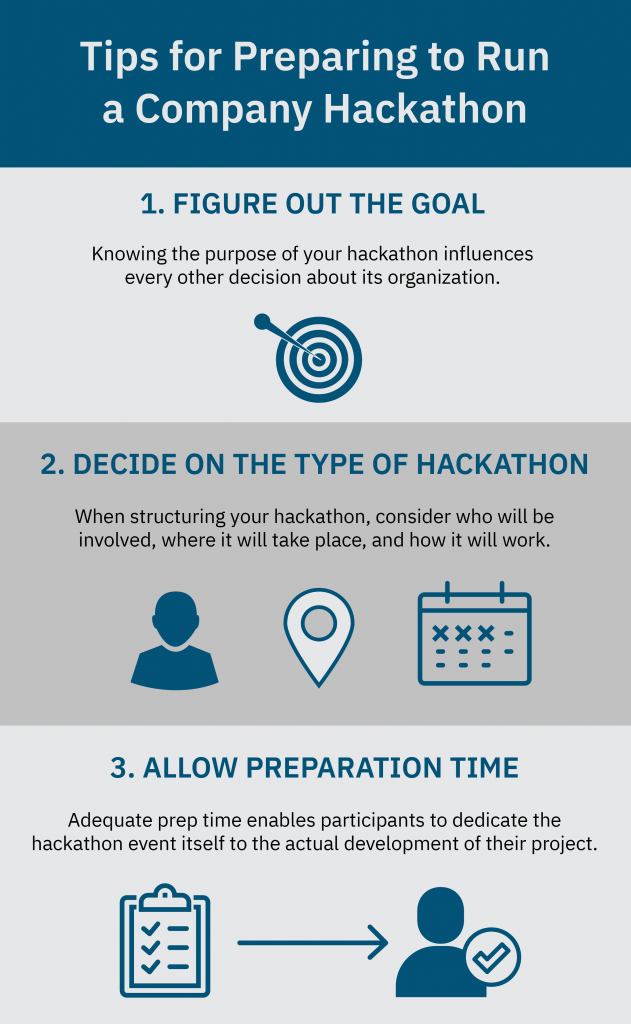Have you ever wondered how to run a company hackathon? If you’re interested in conducting an internal hackathon for your organization, we recommend you consider the following steps to prepare:
- Figure out the goal of the hackathon.
- Decide on the type of hackathon.
- Allow preparation time.
Although hackathons are meant to be a place for spontaneous creativity, laying the proper foundation for your hackathon is key to its success.
Keep reading to learn more about what exactly a company hackathon is, the benefits of running a hackathon, the preparations you can take to make your hackathon a success, and our personal experience with hackathons so far.
WHAT IS A HACKATHON?
When you hear the word “hackathon,” you might conjure images of sleepless IT professionals working for 72 straight hours to come up with brand new inventions while downing caffeine, doodling on whiteboards, and typing frantically on laptops. This is what hackathons look like in most popular media—and in some cases, this is what hackathons are really like.
However, not all hackathons are run in this sprint style. Many of them take place over a series of non-consecutive working hours. And even the ones that are non-stop involve some level of preparation beforehand.
There is no single correct way to run a company hackathon. The structure of the hackathon is much more flexible than reflected in popular media. Hackathons may or may not exclusively involve tech professionals, and they can take place over any duration of time.
So, what exactly is a hackathon? A hackathon is an event where people gather to creatively solve problems. Hackathons can take place over a few hours, days, or even weeks or months. The participants usually form groups of 2–5 individuals who work as a team. Hackathons can involve people working in any specialty, be it software, finance, recruitment, or another field.
Whatever the duration or field of work, hackathons try to foster a creative environment free from typical business restrictions. This setup allows participants to think, work, and collaborate in ways they aren’t often able to while on the job.
WHY RUN A COMPANY HACKATHON?

Hackathons have been on the rise in recent years. In 2018, over 5,600 hackathons were conducted across the globe. That’s a staggering 40% increase from 2016.
It’s no accident or mere fad that’s driven the rising popularity of hackathons worldwide. Running a company hackathon provides a range of potential benefits for both individual employees and your company as a whole.
Consider these benefits of hosting an internal hackathon:
- Shift company mindsets. Even if your employees are happy at their jobs, it’s common for many teams to become stuck in certain habits, often unconsciously. A hackathon can help loosen those seemingly established company mindsets.
- Collaborate with different people. Hackathons typically provide employees the chance to work with those they might not collaborate with on a regular basis. Depending on the particular goals of your hackathon, this might mean that teams within an internal department get shuffled around into new combinations. You might also choose to design a hackathon in which people from multiple departments or with different specialties work together. Some hackathons even choose to invite external participants, sometimes as part of a recruiting effort.
- Increase employee autonomy. Hackathons give employees both time and space to pursue projects they are interested in. Allowing employees this type of freedom helps to breed new ways of thinking about old problems and methodologies.
- Break from the usual day-to-day. Hackathons often focus upon projects or problems outside of an employee’s typical job responsibilities. It is usually a time uninterrupted by the need to help clients, gather for meetings, answer emails, or other normal tasks. A hackathon can provide a refreshing change of pace and the chance for employees to get excited about learning something new.
- Build community. Fostering a company culture that is both productive and supportive can be challenging at times, but a hackathon can help with both. Hackathons tend to generate excitement among participants, which allows them to feel part of a community. A well-structured hackathon helps make new employees feel included and strengthen bonds between coworkers.
- Innovate as individuals and as a company. Whether your business is new or well-established, you likely know that continual innovation is key to your company’s success. There are, of course, multiple ways to support a spirit of innovation within a business. A hackathon is a great way to do so, because it can quickly shake things up and help employees think outside of the box.
HOW TO RUN A COMPANY HACKATHON
Ready to reap the rewards of your very own internal hackathon? Set yourself up for success with these 3 tips for how to run a company hackathon:

1. FIGURE OUT THE GOAL
What do you hope to accomplish with your hackathon? Knowing the answer to this question influences every other decision about how you run a company hackathon, so figuring out the purpose should come before anything else.
The goal of the hackathon can be as broad or as specific as fits your organization’s needs. A broad goal, for example, and a common one for hackathons, is allowing participants to work on passion projects they’ve never had time for among their regular job duties.
A hackathon goal can also be more specific. Maybe your company wants to improve internal communications, find new ways to use your IT systems to support AI technology, encourage a specific demographic to brainstorm solutions, or strengthen your product offerings.
Whether you end up with a narrow or broad focus, the purpose of the hackathon should be shared with participants in advance. Allowing time to brainstorm, form teams, and finish preliminary work before the main event increases the likelihood of your hackathon participants reaching the designated goal.
NEED HELP? ALIGN YOUR HACKATHON GOAL WITH BROADER COMPANY GOALS
If you’re struggling to figure out the goal for your hackathon, consider these steps to ensure your hackathon goal will help you reach your overarching organizational goals.
Identify Your Organization’s Goals
First, identify your organization’s broader goals. Examples include:
- Increasing sales
- Improving the quality of your products or services
- Launching innovative new products or services
- Entering a new marketing
- Improving customer experience and retention
- Streamlining processes and operations
Talking to stakeholders across your organization, from executive leadership to department heads, can give you a comprehensive view of your organization’s strategic priorities if these are not readily available to you.
Prioritize Goals for the Hackathon
Not all goals are created equal. Ideally you will have gathered a variety of organizational goals with potential for your hackathon at this point. Next, you’ll need to prioritize the best one to move forward with.
Prioritize organizational goals based on:
- Urgency
- Impact
- Feasibility
By considering these different factors, you can more ably choose goals, themes, or challenges for your hackathon that will best support the immediate needs and strategy of your organization, while also realizing any limitations.
Align Hackathon Themes with Strategic Objectives
The next step, after you have a clear outline of your organization’s objectives, is to create themes for your hackathon that directly align with these objectives. For example:
- For organizations focused on driving innovation, a hackathon could get staff to experiment with new technologies such as artificial intelligence, blockchain, or IoT. The goal for the hackathon could be to create prototypes for innovative new products or your organization’s processes and operations.
- If your organization’s main goal is to improve customer experience and increase customer retention, your hackathon could focus on addressing specific customer needs and feedback that you outline from the outset. Staff would work on producing new features or entirely new products that solve common customer problems, meet emerging customer needs, or enhance user interfaces and user experiences with improved UI/UX design.
- In cases where operational efficiency and streamlined processes are a priority, your hackathon could center around addressing specific shortcomings or brainstorming new ways to improve the organization. This could involve automating processes, improving data analytics, or finding solutions that optimize resources and reduce waste.
Turn Themes into SMART Goals for the Hackathon
To make your hackathon a success, you need to do more than align its themes with organizational goals. You also need to turn those themes into hackathon objectives that are SMART (Specific, Measurable, Achievable, Relevant, and Time-Bound).
Examples include:
- Produce a working prototype for a new feature or product.
- Find a viable solution to a specific problem with proof of concept.
- Make a detailed plan for how to introduce and use a new technology at your organization.
Staff should be able to achieve these goals within the time set aside for the hackathon, and there should be clear criteria for whether their goal has been met.
Set Yourself Up for Success with Communication and Collaboration
Clear communication throughout the hackathon is critically important to success. From the outset, you should clearly communicate the hackathon’s goals to all staff. Make sure they know not only what they should be doing, but how it ladders up to broader goals at your organization. This serves as additional motivation for employees, because they can see why their work at the hackathon is important.
Be available throughout the hackathon to answer questions and keep staff on the right track without stifling their ideas. Also, be sure to create opportunities for collaboration between different departments. This will better ensure that the work employees produce accounts for every part of your organization. It has the added benefit of providing team building across departments.
Don’t Forget Your Post-Hackathon Follow-Up
Don’t wait until after the hackathon to determine your follow-up steps. Plan all follow-up work ahead of time to make sure it aligns with your hackathon’s goals.
Create a follow-up process that will allow you to measure the hackathon’s outcomes against its goals. This includes:
- Reviewing the work produced during the hackathon
- Identifying projects or solutions that are worth pursuing
- Property rewarding or acknowledging staff who worked on these projects
- Setting aside time, budget, and other resources for these projects and solutions
- Creating a timeline and next steps for these projects or solutions
2. DECIDE ON THE TYPE OF HACKATHON
When it comes to knowing how to run a company hackathon, choosing the right structure is very important. There are several main components to a hackathon structure:
- The who. Will your hackathon be run within one specific department at your company? Will it involve employees from multiple fields? Will you invite external participants?
- The where. Will your event be in-person? If so, do you have the capacity to host the hackathon at your company headquarters, or will you need to rent a space? Or would you prefer your event to take place virtually and all work happen remotely? If so, do participants have all the technology they need within their homes?
- The how. Will your hackathon take place over 24–72 consecutive hours, or will its hours be non-consecutive (for example, a week with 2 hours at the start of each day dedicated to the hackathon)? Can you block off the hours of your hackathon during company time, and if so, how will you handle customers during this time? Or will the hackathon take place during non-traditional work hours?
While determining the answers to all of these questions might feel overwhelming at first, keeping your hackathon goal in mind should help you make these decisions. If, for instance, the goal of your hackathon is to recruit people to a specific department, you may not need any other departments to participate. Or if your goal is to improve on-site communication, allowing virtual participation would probably add confusion.
WHAT ABOUT NON-TECHNICAL STAFF?
Who should participate in a hackathon? Is it just for computer scientists, programmers, coders, engineers, IT professionals, and technical staff? Bringing in non-technical employees can be extremely beneficial.
Solve Problems from Every Perspective
Non-technical staff have different perspectives to bring to the table. This can contribute to more innovative and comprehensive solutions. For example, employees from human resources, accounting, marketing, sales, and other departments can contribute insights technical staff may lack on internal processes and operations, customer needs, and your competition’s strategies.
Not only that, but staff who have a background in business, marketing, or design can contribute significantly to brainstorming sessions. They can help make sure that any technical solutions take into account your organization’s processes end to end, your market needs, or your target audience’s experience and expectations. These employees can also help make sure any new ideas are feasible and would produce an appropriate impact to the organization.
Incorporate Skill Sets to Complement Technical Abilities
Non-technical staff often have skills in project management, which can play an important role at the hackathon. While technical staff might work more on prototyping, non-technical staff can keep the project on track by identifying milestones and creating a timeline.
Even as an internal event, skills in communication and sales are important. Each team must be able to effectively share its idea and pitch its solution. Non-technical team members can take the lead in gathering and presenting this information. This will allow leadership to see a project’s true value and potential, making sure that good ideas don’t get wasted due to poor presentation.
Promote Learning and Development
Participating in a hackathon provides non-technical employees with a chance to learn about new technologies, tools, and methodologies. This can show them the benefits of these technologies and get them excited about getting trained in how to use them, leading to long-term growth and innovation throughout the organization.
Working closely with technical staff on hackathon projects allows non-technical staff to learn more about the technical challenges and opportunities at your organization. This can improve cross-department communication and collaboration in the long term.
3. ALLOW PREPARATION TIME

Whether you decide that your hackathon should be a 24-consecutive-hours marathon or spread out over a more relaxed time frame, allowing both hackathon organizers and participants adequate preparation time is key to achieving your goals.
As with the set-up of your hackathon, this preparation will vary depending upon your particular objectives. But overall, prep time serves to make sure that participants are able to dedicate the hackathon event itself solely to the actual development of their project. They should have already completed the necessary groundwork before the hackathon begins.
This means that, by the time the actual event rolls around, hackathon teams should have already brainstormed ideas, assembled teams, outlined the project design, and ensured that each team member has a clear role with actionable steps. In other words, the logistics should be handled ahead of time so that the hackathon itself can be devoted to team work, problem solving, and development.
Consider offering hackathon teams some help with preparation. Some hackathons, for instance, recruit well-known figures within a related field to give lectures during the prep period. You could also host workshops or training sessions prior to the main event to help get the creative juices flowing. If you’re asking participants to learn new or fledgling skills for the event, consider arranging one-on-one meetings between yourself and participants or between team members and their leader.
HOW TO LEVERAGE PRE-HACKATHON WORKSHOPS AND TRAINING
Equip staff with the knowledge, skills, and mindset necessary to maximize their hackathon experience by providing workshops or training beforehand. These workshops and training can range from developing technical skills, to creative thinking and teamwork.
Workshop Types
- Technical Skills: If your hackathon is exploring new technologies, such as artificial intelligence, blockchain, or IoT, give staff a crash course on the basics so they’ll be prepared for the hackathon.
- Problem Solving: Give staff a primer on how to brainstorm innovative ideas and perform creative problem solving. For example, you could teach them the SCAMPER method.
- Business Models and Pitches: Get staff on the same page about how to create a business model and pitch for their project, including ways to communicate effectively and engage an audience.
- Teamwork and Collaboration: At a basic level, staff need to understand how to establish team roles, communicate, work together, and resolve any disputes that may arise during the hackathon. For more advanced training, consider giving staff an introduction to Agile methodologies and scrum tactics so they can keep up in the fast pace of a hackathon.
Guest Speakers
- Industry Professionals: Invite professionals with deep expertise in your hackathon’s focus area. They can provide insights into industry trends, challenges, and opportunities.
- Academic Professionals: University professors, researchers, or other academics can offer workshops on emerging research, theory, or advanced topics relevant to your hackathon.
- Hackathon Experts: Experienced hackathon organizers or participants can share valuable tips on time management, team collaboration, and how to approach problem-solving under high pressure and time constraints.
Opportunities for Engagement
- Provide Pre-Workshop Prep: Share articles, videos, or basic tutorials beforehand so staff can come prepared to make the most of the workshop.
- Use Real-World Examples: When possible, include case studies or real-world applications of the concepts being taught. This helps show the relevance of the skills and how to apply them in a practical way.
- Make It Interactive: Design workshops or training to include interactive elements, such as Q&As, discussions, and hands-on activities. Breakout sessions for small groups can keep staff engaged and make sure they understand the material. It can also introduce hackathon groups and start the team building process.
- Allow for Q&As: Set aside time for feedback and questions so staff can get the information and answers they need before the hackathon itself.
- Introduce Challenges or Competitions: At the end of technical workshops, give staff a small challenge or competition related to the skill learned. This gives them a chance to try out what they learned in a low-stakes environment before the hackathon. It also creates a sense of fun, motivates staff, and gives everyone a trial run in to work together with their hackathon group.
- Ensure Accessibility: Provide recordings or online sessions for those who cannot attend in person, ensuring all staff have access to the knowledge and skills provided before the hackathon. Anyone who needs more time with the material can also benefit from having access to these resources after the workshop concludes.
SENTIENT DIGITAL, INC’S INTERNAL HACKATHON: OUR EXPERIENCE SO FAR

How exactly do we know how to run a company hackathon? Sentient Digital, Inc. is excited to currently be in the preparation stages for our own internal hackathon!
Our engineering manager, Alex Radka, is responsible for running our hackathon. Radka has participated in several hackathons before, usually run in a traditional style where the hackathon lasts 1–2 consecutive days. At a previous company Radka worked for, he was part of a team that successfully built a prototype for an AI-enabled camera that could pinpoint the location of a gas turbine leak.
Radka says he enjoyed the energizing experience of these marathon sessions and the innovative spirit they fostered. However, for Sentient Digital, Inc’s first marathon, he knew the pace would need to be slowed down. That’s because one of his primary goals for the hackathon was for his team of systems administrators and engineers to learn how to use a scripting tool, PowerShell, that they were unfamiliar with.
Radka wants Sentient Digital, Inc’s hackathon participants to not only have the time to learn a new skill, but also to shift their typical paradigm of thinking about their job functions, systems operations, systems engineering, and administration. Specifically, Radka would like his team to think more about how to automate processes that they currently do manually. “I’m honestly trying to change the culture of this team,” said Radka.
As learning a new skill and way of thinking does not happen overnight, Radka has allotted several months preparation for his hackathon participants. These participants are currently reading The Unicorn Project by Gene Kim, a book about the unique challenges and opportunities provided by the rapidly changing digital landscape, as well as Learn Windows PowerShell in a Month of Lunches, a book about learning PowerShell over the course of a month with just one hour per day. In addition, Radka has been holding bi-weekly one-on-ones with participants to check in on their individual and team progress.
While the main event of the hackathon has yet to happen, Radka has already noticed a shift in approach among some of his team members. In recent months, he has had several employees approach him with new ideas, both for potential hackathon projects and beyond.
“Even in this short time, I seem to be having more of those conversations,” Radka shares.
LET US HELP WITH YOUR INNOVATIONS

At Sentient Digital, Inc. we are proud of our abilities and efforts to continually innovate with new technology, projects, and mindsets. We are excited not only by the chance to run a company hackathon for the first time, but also to continue seeing its ripple effects across our company culture.
If your organization is looking for ways to innovate with technology, we are ready to take on the challenge! Our team is on the cutting edge of multiple tech fields, including cybersecurity, machine learning, software development, IT contracting, and more. Contact us today to learn more about how our companies can innovate together.
Are you a technology professional looking for a dynamic, challenging, and innovative work environment? Contact us about our job opportunities!




